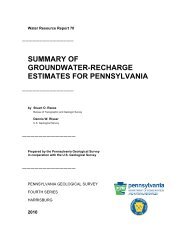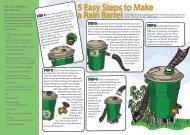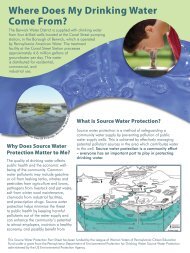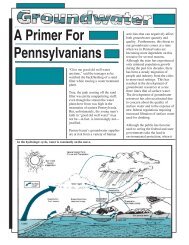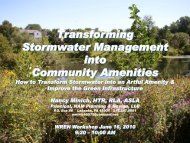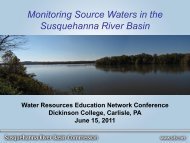NITROGEN POLLUTION: - Hubbard Brook Research Foundation
NITROGEN POLLUTION: - Hubbard Brook Research Foundation
NITROGEN POLLUTION: - Hubbard Brook Research Foundation
Create successful ePaper yourself
Turn your PDF publications into a flip-book with our unique Google optimized e-Paper software.
Why assess nitrogen in the environment<br />
Nitrogen pollution is steadily increasing and has emerged as a pressing<br />
environmental issue of the 21 st century.<br />
Nitrogen is an essential nutrient that is used by all living things. Under pristine<br />
conditions, there is usually not enough nitrogen to go around. Over the past 100 years,<br />
however, conditions have changed. The growing human population has increased<br />
demand for food and energy worldwide. Meeting these demands has increased the<br />
amount of reactive nitrogen 1 in the<br />
environment. The primary processes<br />
developed in the past century that<br />
convert unreactive nitrogen to<br />
reactive nitrogen are the manufacture<br />
of fertilizer, the combustion of fossil<br />
fuels and the planting of nitrogenharnessing<br />
croplands (see Figure 1).<br />
Excess reactive nitrogen in the<br />
environment can lead to pollution<br />
problems, including the deterioration<br />
of air quality, disruption of forest<br />
processes, acidification of lakes and<br />
streams, and degradation of coastal<br />
waters. While the global increase in<br />
reactive nitrogen from human<br />
activities supports higher crop yields<br />
and greater energy production, it also<br />
sets off a series of adverse environmental<br />
changes known as a “nitrogen<br />
cascade.” Given the combination of<br />
Human Population (billions)<br />
Natural N Fixation<br />
1850 1870 1890 1910 1930 1950 1970 1990 2010<br />
Year<br />
Global population<br />
Total reactive N<br />
N fixation in cropland<br />
beneficial and harmful effects, nitrogen pollution in the environment is often<br />
referred to as “too much of a good thing.”<br />
A group of scientists convened by the <strong>Hubbard</strong> <strong>Brook</strong> <strong>Research</strong> <strong>Foundation</strong><br />
examined the sources and consequences of nitrogen pollution in the Northeastern<br />
United States (the Northeast). This report summarizes their findings. The Northeast<br />
provides an interesting case study in nitrogen pollution because this region:<br />
1. has experienced steady population growth which tends to increase reactive<br />
nitrogen in the environment (see Figure 2a);<br />
2. has undergone significant land use change since farm abandonment in the late<br />
1800s, which influences nitrogen retention and loss (see Figure 2a);<br />
3. receives large amounts of reactive nitrogen to the air, land and water; and<br />
4. encompasses a diverse landscape ranging from sparsely populated and<br />
acid-sensitive forests with few sources of nitrogen to densely populated urban<br />
areas with multiple sources of nitrogen (see Figure 2b).<br />
This report addresses three major questions regarding nitrogen pollution in the<br />
Northeast:<br />
1. What are the anthropogenic (i.e. human-derived) sources of reactive nitrogen<br />
2. What are the ecological effects of nitrogen pollution<br />
3. To what extent will policy options reduce nitrogen pollution and mitigate its<br />
effects<br />
Fossil fuel N<br />
Industrial N fixation<br />
FIGURE 1: k<br />
Human activities<br />
have increased the<br />
production of<br />
reactive nitrogen.<br />
From Galloway<br />
and Cowling 2002.<br />
Reactive nitrogen (terragrams per year)<br />
1<br />
Reactive nitrogen refers to all forms of nitrogen that are readily available to biota (largely ammonia,<br />
ammonium and nitrate). Unreactive nitrogen exists mostly as inert N 2<br />
gas. In excess, reactive nitrogen<br />
causes nitrogen pollution.<br />
PAGE 4



